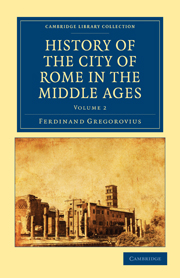Book contents
CHAPTER VI
Published online by Cambridge University Press: 05 July 2011
Summary
WE shall attempt in the present chapter to give some account of the civic institutions of the city in the eighth century.
The three classes of the people
The division of the Roman people into three classes: the sacerdotal, the military, and that of the lower ranks of the citizens, or, in general terms, into clergy, nobles, and populace, has long been known to us. Clergy and nobles, however, at times ranked together under the head of judices and optimates, in the same way that the armed citizens ranked in the militia; a force headed by men conspicuous for their wealth or illustrious descent. To describe the internal organisation of the city, with respect to these great classes by whom the Pope was elected, is for the historian a most questionable undertaking; and the difficulty of the task is further increased by the confusion which prevailed between the spiritual and secular elements.
In the time of the Goths the Roman Church, like every other episcopate, was restricted to her own affairs, which remained quite apart from those of the city. The city continued to retain possession of her municipal constitution and autonomy, to be governed by the Senate and old-established magistracies, and judicially administered by the Prefect.
- Type
- Chapter
- Information
- History of the City of Rome in the Middle Ages , pp. 418 - 458Publisher: Cambridge University PressPrint publication year: 2010First published in: 1894



